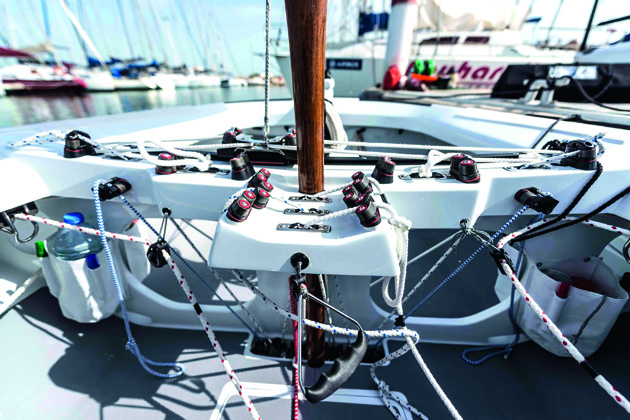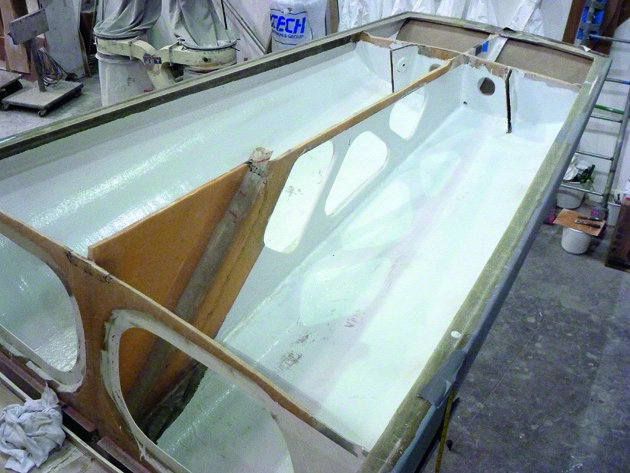One of the most famous keelboat classes in the world gets a huge makeover in Dubai. Matthew Sheahan went to find out more
Receiving Olympic status is not always the blessing you might expect. The rate at which some of the world’s best sailors and teams refine and develop Olympic class boats and the costs that ensue can be a problem in the longer term. You can end up with highly refined boats that often have short competitive shelf lives, taking them out of the normal league for amateur sailors and damaging the grass roots support for a class.
So gaining Olympic credentials can prove to be a poisoned chalice. Some classes have even been said to have actively discouraged the attention of the Olympic committee for fear of alienating their mainstream constituents.
But not the Dragon. Designed in 1929 by Norwegian Johan Anker, the Dragon was made an Olympic class in 1948 and remained one until 1972, since when the elegant and distinctive keelboat has continued to be popular, offering good competition for a broad spread of abilities.
Represented in more than 26 countries, the worldwide fleet is over 1,500 with a high standard of racing for its annual world and European championships as well as the prestigious Gold Cup, which regularly attracts around 100 entries.
On the technical front the class has also managed to strike a careful balance between being a one-design and having areas open to restricted development.
Back to basic design
Yet despite this there have been few, if any, design studies that have gone back to basics and started afresh in optimising the boat. Until now.
Apart from its impressive track record in composite work in architectural, aviation and rail projects, Dubai-based Premier Composite Technology is best known in the marine world for building grand-prix raceboats such as the Farr 400, the GC32 foiling cats and most recently the Farr 280.
But now, after a two-year study that involved designing seven hulls and building five prototypes, the company has launched its brand new, breathed-on Dragon.
Driven by top Dragon sailors Markus Wieser and Hendrik Witzmann, the project pulled in some serious players, including Andy Claughton from the Wolfson Unit in Southampton, Paolo Manganelli, senior engineer at Gurit, and designer Klaus Roeder. They started with seven different hull and keel sections, which were tested using a velocity prediction program (VPP) from which two designs were then selected.
“Initially we looked at a number of radical options,” explains Witzmann. “From these studies there appeared to be some big gains in some areas, but these also meant having to accept some big compromises. In the end we opted for two designs that were more conservative and looked more likely to be good all-rounders.”
While there is room to alter hull shapes within the class rules, the tolerances are small. One example is the measurement around the hull which allows a maximum tolerance of 0.05 per cent at each of the seven templated measurement stations. This translates to a maximum tolerance of 16mm measured away from the hull at midships and just 8mm in the forward sections. The scope for tweaking the hull shape is clearly small, but nonetheless considered to be worthwhile by PCT.
“By creating a shape that is narrow amidships and fuller in her ends we have produced a hull that has a long waterline length,” says Witzmann.
Improved stiffness
Improved stiffness was also a technical goal, especially longitudinally. “Fore and aft stiffness is particularly important on a Dragon because of the running backstays,” continues Witzmann, “as they can induce a good deal of bending in this plane. Keeping the boat stiff maintains the waterline length and hence her maximum speed.”
Also contributing to increased stiffness, the PCT Dragon has all bulkheads bonded into the hull rather than relying on an inner liner for the internal structure.
The hull itself is a solid laminate construction using woven rovings and unidirectional fibres throughout rather than chopped strand mat, of which there is none. The PCT Dragon even avoids the use of gelcoat in order to allow more structural material to be included within the rule limit on panel weight of 12kg/m2 and the resin is vacuum-infused to ensure a tight control on this weight. Under the rules no carbon or Kevlar is allowed in the hull or deck.
But while stiffness was important, so too was keeping weight out of the ends, both in the structure and in the amount of water that might find its way inside. Dispensing with a spinnaker chute and launching the kite from a bag in the cockpit 470-style helped to reduce the weight of the chute and its tube, as well as preventing water being shipped through the bow.
The keel came in for some special attention. “Normally the keels are cast iron, but on this boat we used a CNC milling machine,” says Witzmann. “This is the first time this has been done on a Dragon and the process allows us to get close to the maximum keel weight of 1,010kg, as well as achieving a perfectly symmetrical shape.”
Unlike other Dragons where the ballast for the keel is encapsulated in the hull/keel laminate, the PCT Dragon’s keel is fitted from below and coated with a thin layer of glassfibre, which helps to achieve a slightly lower centre of gravity.
Cockpit layout
But it’s not just the structural elements that have come up for review; the layout of the cockpit has also been studied carefully. Among subtle changes, the coachroof and coamings have been altered to allow better control of the horizontal jib car travellers and more comfortable positions for hiking.
The position of the mainsheet traveller drew plenty of attention as the team tried to exploit all the structural benefit they could from this member, as well as making it more efficient from a sail trim point of view. But the area also provided another important detail: support for the helmsman. Toestraps are not allowed in the class so the shape and positioning of the central unit was refined to allow foot support when hiking.
The theory was put into practice for the first time in October 2013 when the first prototype was launched in Dubai. Since then two boats have been shipped to Europe for further testing. This season the company will start to build production versions and engage in the international circuit.
For all the detailed analysis and testing of the previous two years it is here on the circuit in this fiercely competitive fleet that the results will be revealed and the company finds out whether breathing on the Dragon really has made her fly.
New Dragon in build
The longitudinal bulkhead in the after section extends up to the underside of the deck to maximise the stiffness of the boat in this area
Refining the mainsheet traveller control area helps when it comes to foot support for the helmsman. Toestraps are prohibited by the Dragon class rules
All bulkheads and structural members are laminated into the hull rather than use an inner liner
Among subtle changes, the flared coachroof allows for more efficient horizontal jib travellers
She may be elegant above decks, but a snake pit below as many of the control lines run under deck
Milling the keel from an oversized casting achieves precise weight and a perfectly symmetrical section
This is an extract from a feature in the June issue of Yachting World













